Springs of Ladona
-
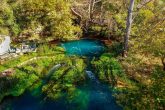
The spring of the Ladonas river -
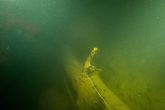
Visibility is always limited due to the milky sediment. -

A reflection formed by the still waters of the lake -
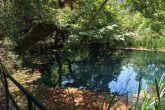
The waters of the Ladonas River spring form a small and beautiful lake -
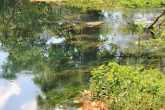
The flora is rich in the spring of Ladonas -
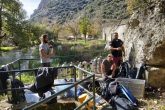
Preparation before diving -
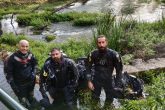
The divers from right to left (Fountas Pitsinelis, Yiannis Liardakis, Antonis Grafas), satisfied after another successful dive -
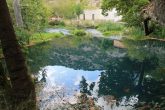
A spurt from the spring of the river Ladonas. In the background, the old dairy farm of the Stavropoulos family can be seen -
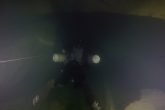
The entrance of the cave -

Video from the Ladonas cave
The Ladon River flows from the Aroania Mountains (Helmos) and specifically from the Pentelian Mountain. It’s springs are located in the area of Lykuria village of Achaia, called “Rahi Pyrgou” or “Kefalovrysso” and flows through sinks with so much power that it could move 20 watermills simultaneously. The end of the summer months provides the best opportunity for divers to dive the spring as there is minimal turbulence and flow due to the reduced rainfall. Hence, taking advantage of this opportunity, we wanted to make an initial approach in the cave where the rivers’ water originates from.
In September 2018, the Grafas Diving diving team visited the spring of the Ladon River. Organized and executed a series of dives for the purpose of filming, photographing, collecting information on the flora and fauna, as well as mapping the cave. Visibility is always limited due to the sediment. The rocks have many alternations, from rock soil, clay and gravel. The temperature is between 12 to 13 degrees Celsius in the autumn months and shows slight fluctuations throughout the year. The morphology of the cave is like to a downhill tube with a slope that reaches 10-15 degrees and a maximum depth of 47 meters. Our team laid a line and explored about 120 meters of the cave, where at the end there is a sudden change in direction. An upwards slope leading to an almost square opening above, reaching a dead end. Due to the extremely low visibility, we chose to continue the exploration when conditions are more appropriate.
A paradox during the dives is that we discovered at 10-15 meters depth, 2 large bullet shells (maybe from anti-aircraft guns) with a relatively high wear from oxidation. Our hypothesis is that the waters of the spring were at some point much lower, possibly prior to these being re-enforced from the waters of lake Fenos, especially during the summer months thus falling to a point which perhaps allowed for this natural cave to serve as a hiding place during the war. The location where these shells were found due to the tilt of the cave prevents us to believe these could have rolled down from the surface of the water. Unfortunately, there are no written or verbal references to prove this fact, at least for the time being.

